| Lutjanidae | |
|---|---|
 | |
| Humpback red snapper, Lutjanus gibbus | |
| Scientific classification | |
| Domain: | Eukaryota |
| Kingdom: | Animalia |
| Phylum: | Chordata |
| Class: | Actinopterygii |
| Order: | Perciformes |
| Family: | Lutjanidae T. N. Gill, 1861[1] |
| Subfamilies | |
|
see text | |
Lutjanidae, or snappers are a family of perciform fish, mainly marine, but with some members inhabiting estuaries, feeding in fresh water. The family includes about 113 species. Some are important food fish. One of the best known is the red snapper.
Snappers inhabit tropical and subtropical regions of all oceans. Some snappers grow up to about 1 m (3.3 ft) in length, and one specific snapper, the cubera snapper, grows up to 1.52 m (5 ft 0 in) in length.[2] Most are active carnivores, feeding on crustaceans or other fish,[3] though a few are plankton-feeders. They can be kept in aquaria, but mostly grow too fast to be popular aquarium fish. Most species live at depths reaching 100 m (330 ft) near coral reefs, but some species are found up to 500 m (1,600 ft) deep.[3]

As with other fish, snappers harbour parasites. A detailed study conducted in New Caledonia has shown that coral reef-associated snappers harbour about 9 species of parasites per fish species.[4]
Timeline
Gibola

Systematics
Lutjanidae is subdivided into four subfamilies and 17 genera with around 110 species, as follows:[5][6][1]
- subfamily Apsilinae Johnson, 1980
- genus Apsilus Valenciennes, 1830
- genus Lipocheilus Anderson, Talwar & Johnson, 1977
- genus Paracaesio Bleeker, 1875
- genus Parapristipomoides Kami, 1963
- subfamily Etelinae Gill, 1893
- genus Aphareus Cuvier, 1870
- genus Aprion Valenciennes, 1830
- genus Etelis Cuvier, 1828
- genus Pristipomoides Bleeker, 2020
- genus Randallichthys Anderson, Kami & Johnson, 1977
- subfamily Lutjaninae Gill, 1861
- genus Hoplopagrus Gill, 1861
- genus Lutjanus Bloch, 1790
- genus Macolor Bleeker, 1860
- genus Ocyurus Gill, 1862
- genus Pinjalo Bleeker, 1873
- genus Rhomboplites Gill, 1862
- subfamily Paradicichthyinae Whitley, 1930
- genus Symphorichthys Munro, 1967
- genus Symphorus Günther, 1872
Some authorities classify the Caesionidae, the fusiliers, within the Lutjanidae as a fifth subfamily but the 5th Edition of Fishes of the World retains this grouping as a distinct family pending more work being conducted on its relationships.[5]

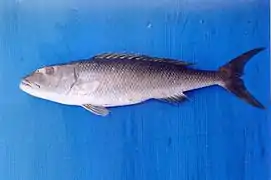
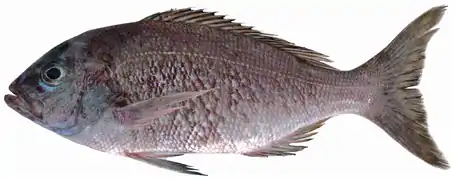
 Etelis radiosus
Etelis radiosus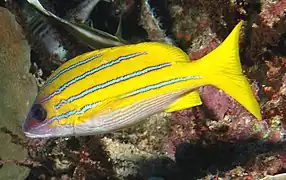

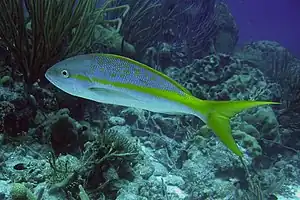
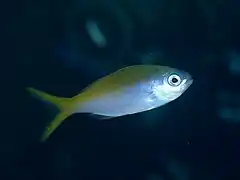
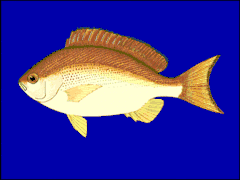
 Pristipomoides aquilonaris
Pristipomoides aquilonaris
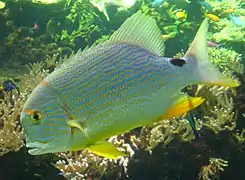
References
- 1 2 Richard van der Laan; William N. Eschmeyer & Ronald Fricke (2014). "Family-group names of Recent fishes". Zootaxa. 3882 (2): 001–230. doi:10.11646/zootaxa.3882.1.1. PMID 25543675.
- ↑ "Cubera Snapper". blog.mountthis.net. Retrieved 2017-02-15.
- 1 2 Bray, Dianne. "LUTJANIDAE". Fishes of Australia. Archived from the original on 9 October 2014. Retrieved 29 September 2014.
- ↑ Justine, Jean-Lou; Beveridge, Ian; Boxshall, Geoffrey A; Bray, Rodney A; Miller, Terrence L; Moravec, František; Trilles, Jean-Paul; Whittington, Ian D (2012). "An annotated list of fish parasites (Isopoda, Copepoda, Monogenea, Digenea, Cestoda, Nematoda) collected from Snappers and Bream (Lutjanidae, Nemipteridae, Caesionidae) in New Caledonia confirms high parasite biodiversity on coral reef fish". Aquatic Biosystems. 8 (1): 22. doi:10.1186/2046-9063-8-22. ISSN 2046-9063. PMC 3507714. PMID 22947621.

- 1 2 J. S. Nelson; T. C. Grande; M. V. H. Wilson (2016). Fishes of the World (5th ed.). Wiley. pp. 457–458. ISBN 978-1-118-34233-6.
- ↑ Eschmeyer, William N.; Fricke, Ron & van der Laan, Richard (eds.). "Genera in the family Lutjanidae". Catalog of Fishes. California Academy of Sciences. Retrieved 4 May 2021.